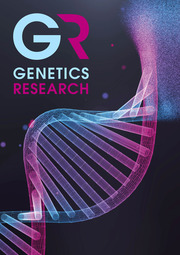Crossref Citations
This article has been cited by the following publications. This list is generated based on data provided by
Crossref.
Plat, Marika
and
Condamine, Hubert
1984.
Recombination between two mouse t haplotypes (t w12 tf) and t Lub-1) : Mapping. of the H-2 complex relative to centromere and tufted (tf) locus.
Immunogenetics,
Vol. 20,
Issue. 3,
p.
277.
Artzt, Karen
1984.
Gene mapping within the T/t complex of the mouse. III: t-lethal genes are arranged in three clusters on chromosome 17.
Cell,
Vol. 39,
Issue. 3,
p.
565.
Frischauf, A.-M.
1985.
The T/t complex of the mouse.
Trends in Genetics,
Vol. 1,
Issue. ,
p.
100.
Silver, Lee M.
Cisek, Lois
Jackson, Catherine
and
Lukralle, Deborah
1985.
A new spontaneous mutation at the tufted locus within a mousethaplotype.
Genetical Research,
Vol. 45,
Issue. 1,
p.
107.
Rogers, John H.
Lyon, Mary F.
and
Willison, Keith R.
1985.
THE ARRANGEMENT OF H‐2 CLASS I GENES IN MOUSE t HAPLOTYPES.
International Journal of Immunogenetics,
Vol. 12,
Issue. 3,
p.
151.
Artzt, Karen
1986.
Genetic analysis of the T/t complex.
Human Immunology,
Vol. 15,
Issue. 4,
p.
374.
Klein, J.
Golubić, M.
Budimir, O.
Schöpfer, R.
Kasahara, M.
and
Figueroa, F.
1986.
The Wild Mouse in Immunology.
Vol. 127,
Issue. ,
p.
239.
Herrmann, Bernhard
Bućan, Marija
Mains, Paul E.
Frischauf, Anna-Maria
Silver, Lee M.
and
Lehrach, Hans
1986.
Genetic analysis of the proximal portion of the mouse t complex: Evidence for a second inversion within t haplotypes.
Cell,
Vol. 44,
Issue. 3,
p.
469.
Willison, Keith R.
Dudley, Keith
and
Potter, Jean
1986.
Molecular cloning and sequence analysis of a haploid expressed gene encoding t complex polypeptide 1.
Cell,
Vol. 44,
Issue. 5,
p.
727.
Lyon, Mary F.
1986.
Male sterility of the mouse t-complex is due to homozygosity of the distorter genes.
Cell,
Vol. 44,
Issue. 2,
p.
357.
Justice, Monica J.
and
Bode, Vernon C.
1986.
Induction of new mutations in a mouset-haplotype using ethylnitrosourea mutagenesis.
Genetical Research,
Vol. 47,
Issue. 3,
p.
187.
Goodfellow, P. N.
1990.
A long story and a short tail.
Nature,
Vol. 343,
Issue. 6259,
p.
597.
Klein, Jan
1991.
Maps of mouse chromosome 17: First report.
Mammalian Genome,
Vol. 1,
Issue. 1,
p.
5.
Taylor, Douglas R.
Saur, Meaghan J.
and
Adams, Erika
1999.
POLLEN PERFORMANCE AND SEX‐RATIO EVOLUTION IN A DIOECIOUS PLANT.
Evolution,
Vol. 53,
Issue. 4,
p.
1028.
Capillon, Caroline
and
Atlan, Anne
1999.
EVOLUTION OF DRIVING X CHROMOSOMES AND RESISTANCE FACTORS IN EXPERIMENTAL POPULATIONS OFDROSOPHILA SIMULANS.
Evolution,
Vol. 53,
Issue. 2,
p.
506.
Price, Tom A. R.
and
Wedell, Nina
2008.
Selfish genetic elements and sexual selection: their impact on male fertility.
Genetica,
Vol. 132,
Issue. 3,
p.
295.
Price, Tom A. R.
and
Wedell, Nina
2008.
Selfish genetic elements and sexual selection: their impact on male fertility.
Genetica,
Vol. 134,
Issue. 1,
p.
99.
Erickson, Robert
2022.
Twentieth Century Mouse Genetics.
p.
57.
Erickson, Robert P.
2024.
The T‐locus – inspiration and distraction?.
BioEssays,
Vol. 46,
Issue. 12,

